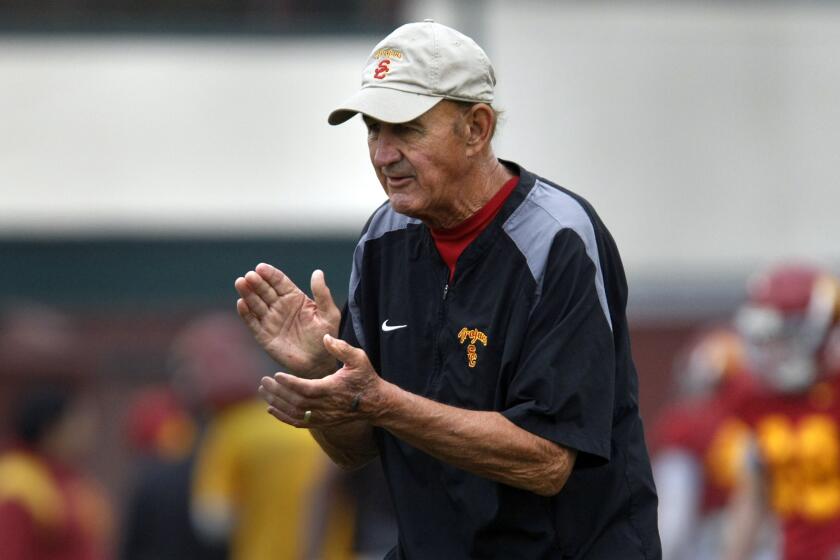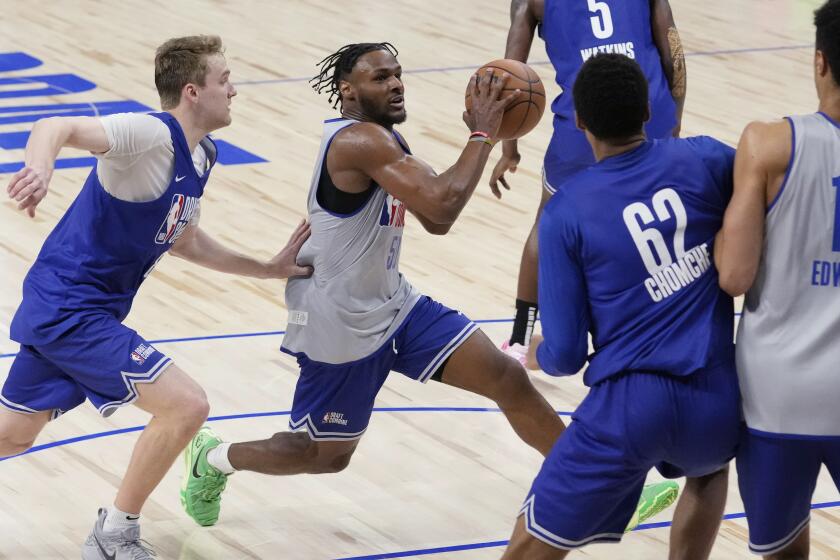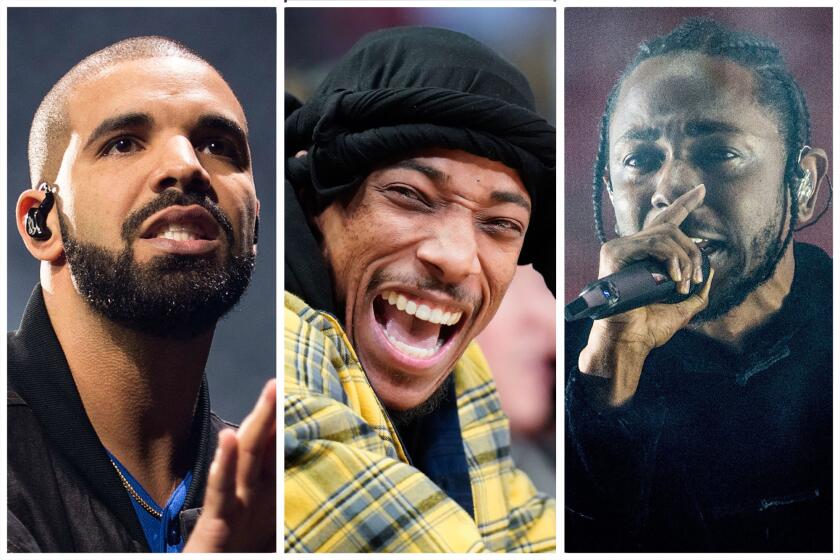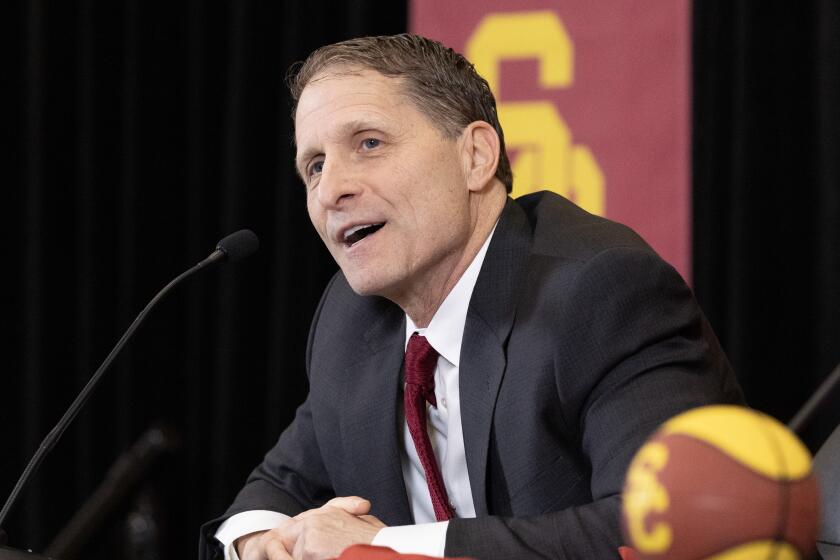Rose Bowl: USC vs. NORTHWESTERN, Jan. 1, Channel 7, 2 p.m. : Howard’s End : Jones Began USC’s Football Success in the 1920s; So What if He Wasn’t Ever Going to Be Life of a Party?
Even the youngest among them are old men now, bent by the weight of their years . . . yet still inspired by memories of their stone-faced leader, Howard Jones.
As USC prepares for its 28th Rose Bowl appearance this week, the oldest Trojans remember the man who established USC as a Rose Bowl team.
Once they numbered in the hundreds. Now, fewer than 20 of Howard Jones’ players remain, all in their 70s and 80s. Decades ago, they went to one another’s weddings. Now . . .
Joe Shell, the 1939 captain, put it, “Seems like we meet more at funerals now than we do at reunions.”
Howard Jones died of a heart attack in the summer of 1941, after 16 USC seasons, during which he won three undisputed national championships and shared the honor in three other seasons. He was 5-0 in Rose Bowl games.
His players remember where they were when they heard the news, just as they remember getting the news of Pearl Harbor only months later.
“I was surfing at San Onofre, and I heard it on my car radio,” recalled one of Jones’ quarterbacks, Amby Schindler, 78. “It was a terrible shock. He was such a force in my life. I guess I assumed he’d be around all my life.”
Recalled another quarterback, Bobby Robertson, also 78, “I lived on campus and I heard it on the radio. I had one more year left at SC and it was a shock, to realize that I wouldn’t finish my career with him there. I cried.”
Jones has been called cold, aloof, introverted, uncommunicative, humorless . . . and one of college football’s great coaches. And he was all of those things.
But he was also the man no one knew.
The two most famous coaches in America in the 1930s were Howard Jones and Notre Dame’s Knute Rockne. But that’s all they had in common--fame and coaching. Compared to Jones, Rockne was an evangelist.
“Jones was a terrible public speaker,” recalled Shell. “He just couldn’t connect with an audience. For one thing, he had no sense of humor. He couldn’t tell a joke right. This was a guy who was totally absorbed in football. The players never felt very close to him, yet we all had absolute confidence in him.”
Schindler said, “I don’t think anyone really knew him well, not even his assistant coaches.
“It was his personality. He was not the kind of guy you ran up to and hugged. No one ever called him anything but ‘Coach’ or ‘Mr. Jones.’ ”
Recalled Al Krueger, 76, “If I saw him walking down the sidewalk toward me before he saw me, I’d cross the street and walk on the other side. He was a formidable man. He intimidated me.
“But he was a great coach and when he talked, you listened.”
Several years ago, the late Ray George, a 1930s Jones player, recalled the Jones “look.”
“If you’d just made a good play and were coming off the field, he wasn’t the type to pat you on the back, shake your hand or say something. He just gave you that look, just a hint of a smile, and you’d know if he was happy.”
Nick Pappas, who started for three of Jones’ teams in the 1930s, recalled the coach’s presence.
“Off the field, his personality was practically nothing,” he said. “But on the practice field, he was electrifying. You could sense the electricity when he walked onto the field. You didn’t have to turn around and look, you knew he was there.”
The stone-faced, severe-looking Jones loved to play bridge, maintained a 10-handicap golf game at Brentwood Country Club and tried to take an Eastern Sierra fishing trip at least once in the off-season.
Paul Zimmerman, former Times sports editor, accompanied Jones on one of the trout-fishing trips and for years has told of finding Jones seated on a rock beside the mountain stream, not fishing but scribbling football notes in a small note pad.
Jones, who had achieved prominence at Iowa, where his teams were 42-17-1, came to USC in 1925--after Rockne turned down a $100,000 USC offer to leave Notre Dame, recommending Jones. The Trojans got Jones for $10,000. Sixteen years later, when he died, he was earning $15,000.
He had his greatest years early at USC. His first three teams were 27-5-1, but at that, better days were ahead. The Trojans won national championships in 1928, 1931 and 1932.
Jones’ predecessor at USC, Elmer Henderson, had been 45-7 in six seasons, but college football exploded in popularity at about the time Jones moved to USC. Many Trojan games were broadcast nationally and Jones’ teams were called “the Thundering Herd.”
He wasn’t loved by everyone, however.
Bill Radovich, 80, says Jones’ formidable personality was in itself a flaw.
“You couldn’t disagree with him on anything,” he said.
“We weren’t winning in my years [1935-37] and there was grumbling. He very seldom had his 11 best players on the field. He’d get it in his head that one guy was going to play, and that was it.
“He wouldn’t even tolerate a discussion about it.
“But as far as his integrity, his scruples, he was untouchable. If he had to bend the rules to win, well, he wouldn’t have done it.”
To be a USC football player in the 1930s was to experience true star status.
“We were the biggest thing in town,” Schindler recalled.
“Nothing was even close. You could just walk around town, go into any restaurant . . . and people knew who you were. They walked up and introduced themselves.
“SC was really well connected in those days with the movie industry. A lot of us had summer jobs at the studios. I was Jack Haley’s double in ‘The Wizard of Oz.’ I made enough money to buy a car.”
Recruiting, generally, wasn’t much of a problem then. But it was a problem for Jones.
“Jones recruited very few players,” Shell recalled. “He didn’t like it. He had trouble talking to people. He relied on his assistants for most of that.”
And his three assistants, Bob McNeish, Hobbs Adams and Jeff Cravath, enabled Jones to bounce back from some lean mid-30s seasons after his early success.
After 1933, Jones’ teams went from the very best to ordinary. He had only one winning season from 1934 to 1938. Whispers began. The game has passed him by. He isn’t playing the right players. He won’t recruit.
But McNeish, Adams and Cravath brought in the players who enabled USC to win two more Rose Bowls, in 1939 and 1940. USC was 17-2-2 those two years.
Jones’ best-remembered victories were the 16-14 upset of Notre Dame at South Bend in 1931 and the 1939 Doyle Nave-to-Krueger Rose Bowl pass that beat Duke, 7-3.
He lived in Toluca Lake, at the corner of Ponca Avenue and Moorpark Street, in a two-story Mediterranean-style house that still stands.
On the hot Sunday morning of July 27, 1941, Jones’ wife, Jane, was not at home. He washed and waxed his car, then, feeling ill, he called his doctor, who lived nearby. When the physician arrived, he found Jones, 55, dead.
Several thousand people attended his funeral at First Methodist Church in Hollywood.
Howard Harding Jones was buried in Woodlawn Cemetery at Middletown, Ohio.
*
In 1946, a group of USC alumni decided that a proper memorial for Jones would be an 8,000-seat campus arena. A site was selected, at the corner of 35th and McClintock, and a fund-raising program was launched.
The project would satisfy, according to a 1946 edition of the USC alumni newsletter, “a crying need” for a USC basketball facility.
Fifty years later, ground still has not been broken.
Go beyond the scoreboard
Get the latest on L.A.'s teams in the daily Sports Report newsletter.
You may occasionally receive promotional content from the Los Angeles Times.



